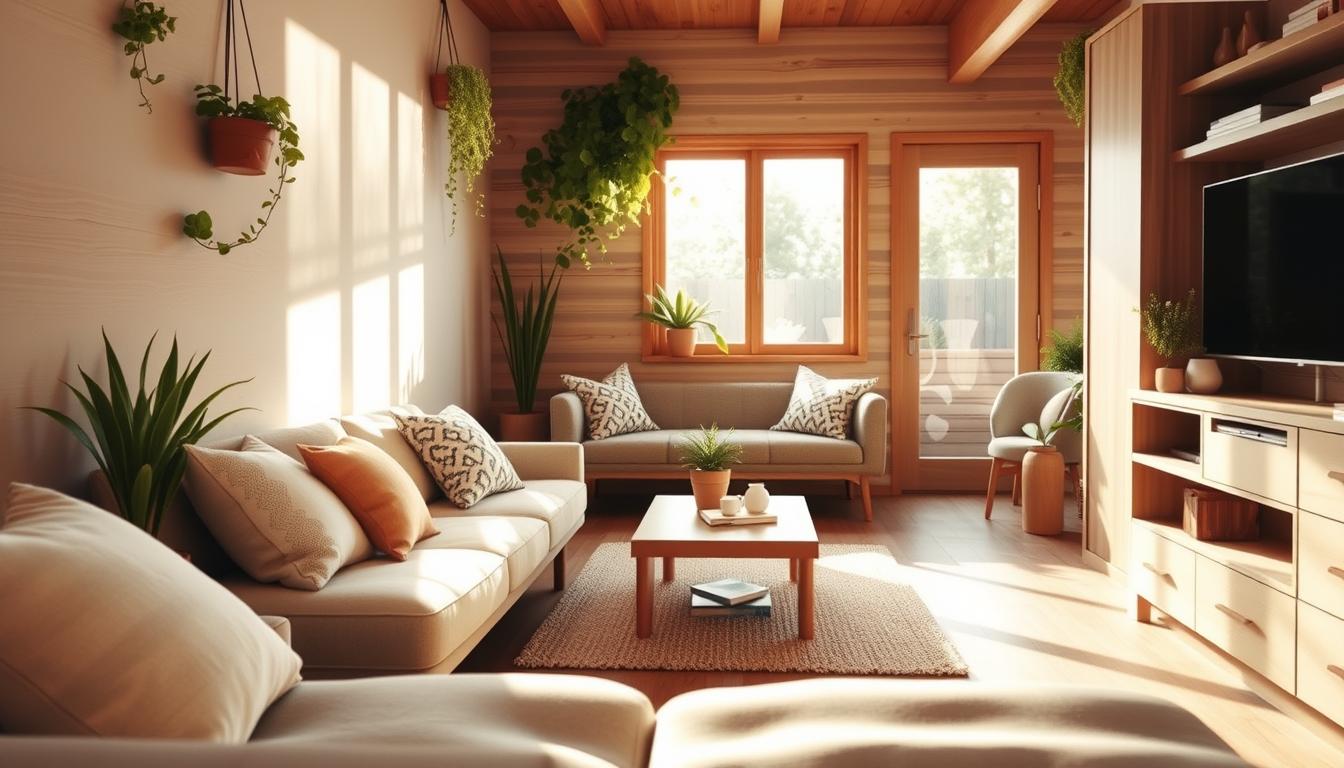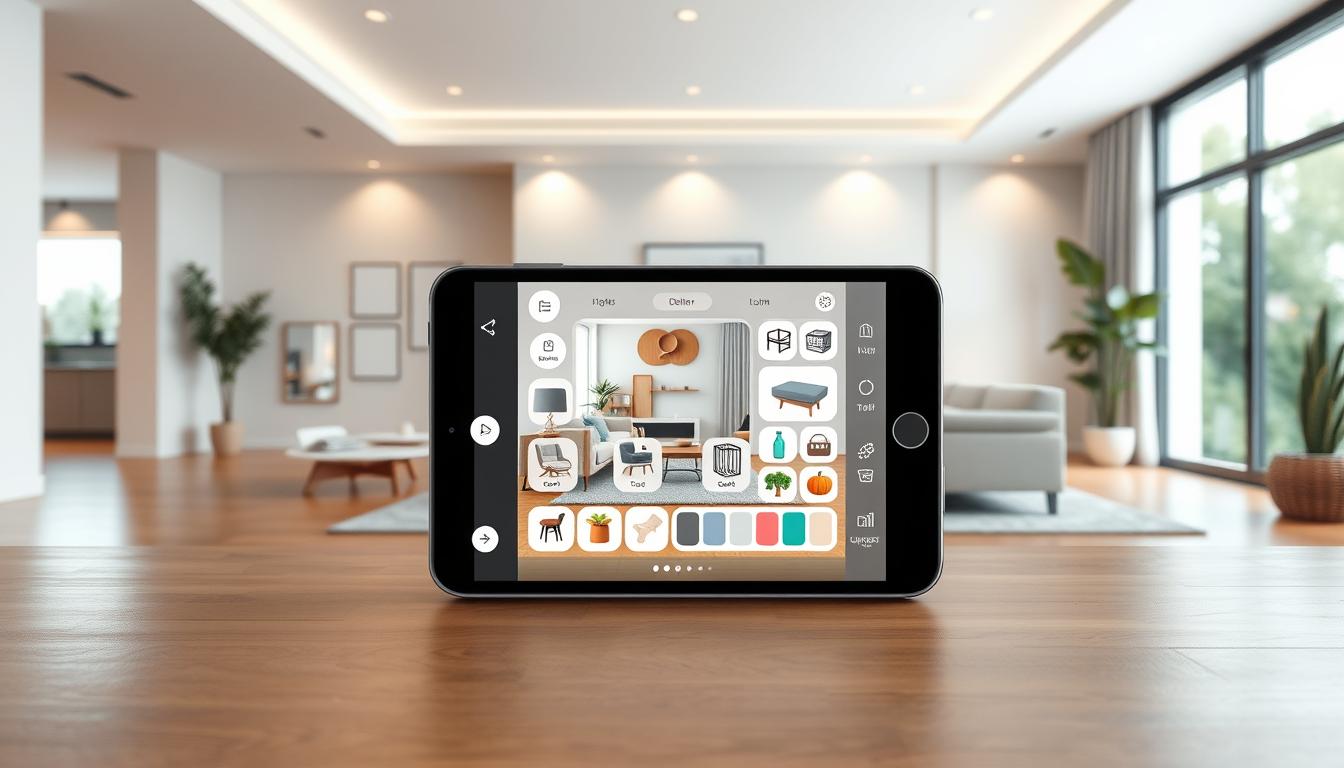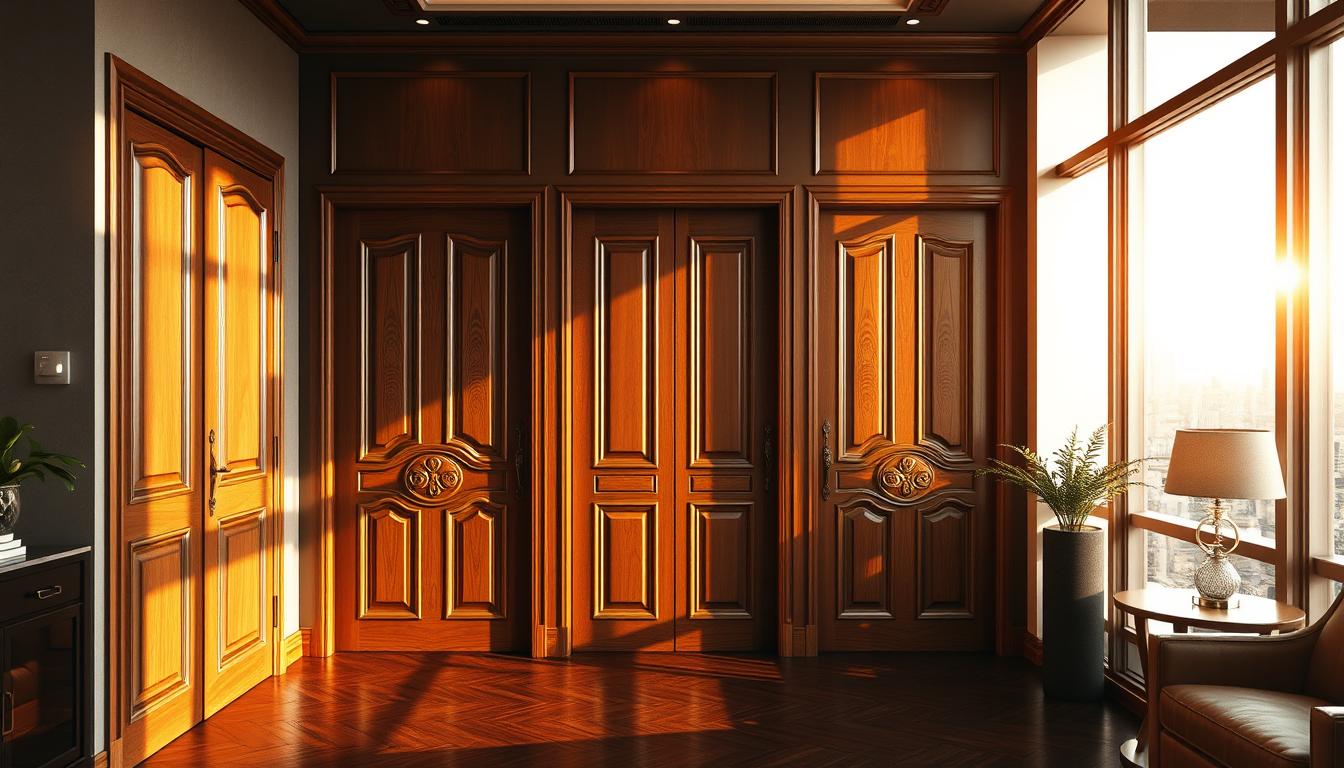The world is moving towards more sustainable living, and minimalist living is getting more popular. The tiny home movement has grown by 67% in recent years. Many people choose small space design to lessen their environmental impact.
Designing a tiny house is a fun challenge. It pushes for creative solutions, layouts that do more than one thing, and smart storage. We’ll look at why these are key to making cozy and useful living areas.
By going for minimalist living, people can live more organized and clutter-free. We aim to share our best tips on making tiny home interiors look good and work well.
Key Takeaways
- Efficient storage is crucial in tiny home design.
- Multifunctional layouts can greatly enhance living spaces.
- Innovative solutions are key to comfortable tiny home living.
- Minimalist living promotes a clutter-free life.
- Small space design requires careful planning.
Understanding the Unique Challenges of Tiny Home Design
Tiny homes come with their own set of design hurdles. Every inch matters, making space use crucial.
One big challenge is space limitations. Tiny homes have smaller rooms and narrower paths. It’s key to plan the layout well to use space wisely.
Space Limitations
To beat space issues, going minimalist is smart. Choose space-saving furniture like wall-mounted desks or foldable tables. This frees up floor space, making the area feel bigger and more flexible.
Using vertical space is another smart move. Wall shelves or storage units that reach the ceiling offer lots of storage without taking up floor space. This keeps the area feeling open and airy.
Maximizing Storage Solutions
Maximizing storage is vital in tiny home design. Look for hidden spots like under stairs or above toilets for storage.
Creative storage ideas include multi-functional furniture like ottomans with storage or beds with drawers. These items do more than one thing, helping to keep your space tidy and organized.
By tackling these challenges, homeowners can craft a micro home interior that’s both useful and looks great. They make the most of every inch.
Essential Elements in Tiny Home Interiors
The secret to a great tiny home interior is using space wisely and keeping it cozy. We do this by picking key elements that do more than one thing.
Choosing Multi-Functional Furniture
Using furniture that does double duty is smart for tiny homes. For example, a storage ottoman can be a seat and a place to store things. A murphy bed or sofa bed turns a room into a bedroom, saving space.
Think about what you need in your tiny home when picking furniture. A desk with built-in storage is great for working from home. A window seat with storage is perfect for reading and keeping books.
Color Schemes for Small Spaces
Colors are key in making small spaces look bigger or cozier. The right colors can make a space feel bigger or more inviting. Stick to four to five colors that go well together.
In a compact home layout, use light colors on walls and big surfaces. This makes the space feel open. Use darker or bolder colors for accents to add depth. This makes your home look better and keeps it simple.
The right colors can really change how your tiny home feels. By picking colors that match and suit you, you create a space that’s both beautiful and useful.
Creating an Open and Airy Feel
An open and airy feel is possible in tiny homes with smart design. We’ll look at how mirrors and natural light can help make your space feel bigger.
Using Mirrors Strategically
Mirrors can make a room look larger by reflecting light and images. Place mirrors opposite windows to bounce natural light and views, enhancing the room’s feel.
A big mirror above a sofa or fireplace adds depth. For a softer look, try a collage of small mirrors. This adds interest without feeling too busy.
Incorporating Natural Light
Natural light is key to making tiny homes feel roomier. Design each room to maximize light. Use sheer curtains or blinds to let sunlight in while keeping privacy.
Skylights and big windows bring in more light. Think about your home’s layout to catch sunlight all day.
| Design Element | Benefit | Implementation Tip |
|---|---|---|
| Mirrors | Creates illusion of more space | Place opposite windows |
| Natural Light | Makes space feel larger and welcoming | Use sheer curtains and consider skylights |
| Light Colors | Enhances brightness and openness | Use on walls and furniture |
With these tips, your tiny home can feel more open and airy. It will feel bigger and more welcoming.
Smart Layout Strategies for Tiny Homes
Creating a functional and efficient layout is key in tiny homes. Every square foot matters. We’ll look at how to optimize your micro home interiors with smart strategies.
When designing a tiny home, layout planning is crucial. A well-thought-out layout can greatly improve your home’s livability and comfort.
Open Floor Plans
Open floor plans are common in tiny homes. They eliminate partitions, making your home feel larger. For more tips on small space design, check out our blog post on interior design for tiny homes.
Zoning Different Areas
Even with open floor plans, zoning areas is vital. Use area rugs, different lighting, or smart furniture to create zones. This boosts your compact home layout‘s functionality and space use.
| Layout Strategy | Benefits | Challenges |
|---|---|---|
| Open Floor Plan | Makes the home feel larger, enhances natural light | Can lack privacy, difficult to define separate areas |
| Zoned Areas | Defines different spaces, enhances functionality | Requires careful planning, can feel fragmented |
By using these smart strategies, you can create a tiny living room that feels spacious and inviting. The key is to be intentional with your design choices and maximize your space.
Optimizing Vertical Space in Interiors
To make tiny homes feel open and functional, it’s key to use the vertical space well. This approach keeps floors and surfaces free, making the area seem bigger and easier to handle.
Utilizing Wall Shelves
Wall shelves are a smart choice for storing things without taking up floor space. They help keep belongings tidy and easy to access. Floating shelves are a favorite for their sleek, modern look.
Vertical Gardens
Vertical gardens, or living walls, are a creative way to use vertical space. They bring greenery into your home and clean the air. You can start with a simple trellis or go for a full hydroponic wall.
Adding wall shelves and vertical gardens to your tiny home decor is all about minimalist living. It helps create a tidy and calm space, which is central to tiny house decor.
Optimizing vertical space offers many benefits:
- More storage
- A neater living area
- Better looks
Incorporating Personal Style
Personalizing a tiny home’s interior is more than just looks. It’s about making a space that works well and shows who you are. Finding the right mix of style and function is key.
To get this balance, add personal decor touches that make your home unique. This might mean showing off personal items like art, family photos, or collectibles. But do it in a way that doesn’t make the space feel cramped. For more ideas, check out tiny house plans for creative designs.
Personal Decor Touches
Adding personal touches can turn a tiny home into a cozy, welcoming space. Think about using items that mean a lot to you or show your interests. For example, a vintage rug can add charm to your living room. Or, a collection of travel souvenirs can make your space feel more like home.
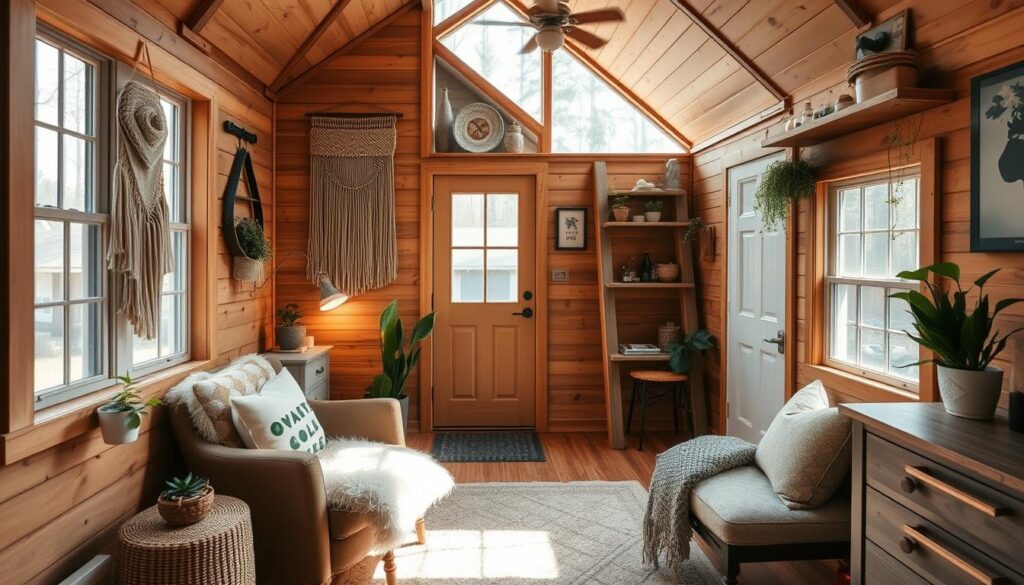
Balancing Aesthetics with Functionality
Looks are important, but function is key in a tiny home. Choose decor that does double duty. Like a storage ottoman that’s also a place to sit. This way, you get both beauty and practicality in your space.
In tiny homes, every choice matters, including how you add personal style. By carefully choosing decor and balancing looks with use, you can make a tiny home that feels big, welcoming, and truly yours.
The Importance of Lighting
Lighting is key in tiny homes, making them feel open and cozy. It lights up the space and shapes its mood and feel.
In micro homes, smart lighting choices really matter. It’s not just about light; it’s about making the space feel warm and big.
Layering Different Light Sources
We suggest using different light sources to brighten and welcome your space. Mix overhead lights, table lamps, and floor lamps for a cozy glow.
- Overhead lights give overall brightness, like recessed or ceiling lights.
- Table and floor lamps add focused light, perfect for reading or highlighting areas.
This layered lighting makes your compact home feel bright and inviting. It maximizes the space you have.
Choosing Energy-Efficient Options
When picking lights for tiny homes, think about saving energy. Eco-friendly lights cut down on waste and save money on bills.
LED bulbs are a top pick because they use less power and last longer. They’re a smart choice for saving money over time.
Using dimmers also boosts energy savings. They let you adjust light levels, cutting down on energy use.
Sustainable Design Practices
When designing our tiny homes, we must think about their environmental impact. Sustainable living is key, not just a trend. It’s essential for tiny house decor and minimalist living. Making smart choices about materials and energy use can greatly reduce our environmental footprint.
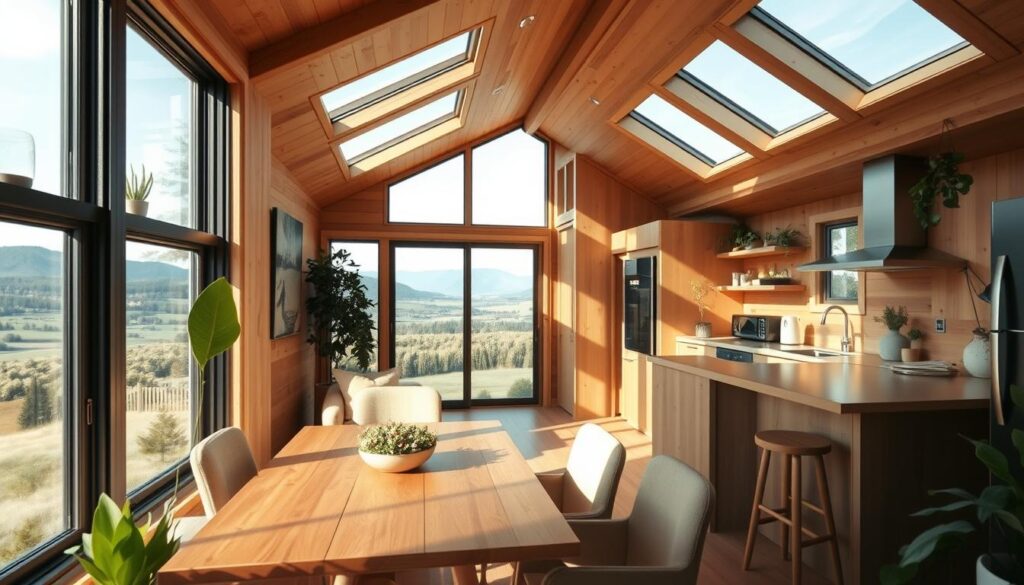
Eco-Friendly Materials
Choosing the right materials is vital for a sustainable tiny home. We should pick materials that are durable and good for the environment. Options include reclaimed wood, bamboo, and paints with low VOCs. These choices help reduce waste and improve air quality, making our homes healthier.
“Sustainability is no longer a choice but a necessity. The way we design our homes can significantly impact the environment,” says a renowned architect. By using eco-friendly materials in our tiny homes interior, we help create a more sustainable future.
Building for Energy Efficiency
Energy efficiency is crucial in sustainable design. We can achieve this by insulating our homes well, using energy-efficient appliances, and adding renewable energy sources like solar panels. This reduces our need for non-renewable energy and lowers utility bills, fitting the minimalist living lifestyle.
- Use LED lighting to reduce energy consumption.
- Invest in a programmable thermostat to optimize heating and cooling.
- Consider adding solar panels to harness renewable energy.
By adopting these sustainable design practices, we can build tiny homes that are beautiful, functional, and eco-friendly. It’s about making choices that benefit us and the planet.
Outdoor Spaces and Extensions
Outdoor areas can greatly expand the living space of tiny homes. They make tiny homes more livable and functional.
Even small outdoor spaces can be turned into beautiful and useful areas. You can add a balcony or patio. Or, bring nature inside with natural materials and plants.
Creating Inviting Balconies and Patios
Balconies and patios are great for expanding your living space outside. Here are some tips:
- Choose furniture that fits your small space well.
- Add plants for color and texture.
- Use lights to make the space inviting at night.
Integrating Nature into Your Design
You can bring nature into your tiny home with natural materials and plants. This makes your home look better and connects you to the outdoors.
Here are some ways to do it:
- Use natural materials for floors, walls, and furniture.
- Try a vertical garden or living wall.
- Decorate your balcony or patio with plants and flowers.
These steps help blend indoor and outdoor spaces. Your tiny home will feel bigger and more connected to nature.
Final Thoughts on Tiny Home Living
Living in a tiny home is more than just a small space. It’s about choosing a simple and minimalistic lifestyle. We’ve talked about how to make the most of tiny spaces, add personal touches, and create a beautiful home.
Simplifying Your Space
Choosing to live minimally means being careful with what we own. By keeping only what’s necessary, we make our homes peaceful and organized. This is key for tiny home design, where every item should have a purpose.
The Benefits of Downsizing
Downsizing brings many benefits, like less clutter and lower costs. By focusing on simple and functional design, we can have a beautiful and eco-friendly home. Simplifying our lives helps us focus on what’s truly important, enhancing our tiny home experience.

